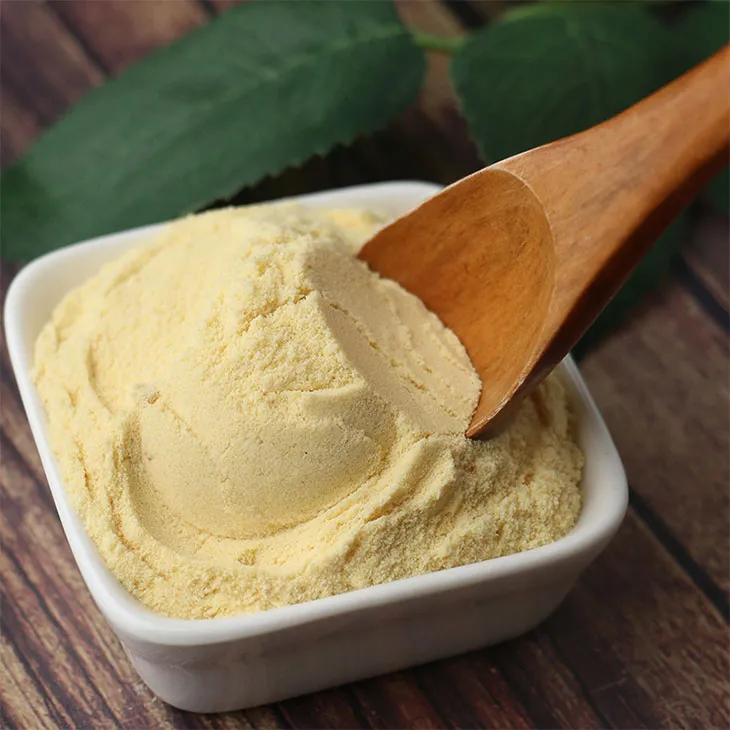- 0086-571-85302990
- sales@greenskybio.com
Organic supercritical CO₂ extraction of American ginseng root extract.
2024-11-28

1. Introduction
American ginseng (Panax quinquefolius) has been highly regarded in traditional medicine for its numerous health - promoting properties. The root of American ginseng contains a variety of bioactive compounds, among which ginsenosides are the most important ones. Extracts from American ginseng root are used in the pharmaceutical, nutraceutical, and cosmetic industries. Therefore, the extraction method plays a crucial role in obtaining high - quality extracts. Supercritical CO₂ extraction is emerging as a very promising technique in this regard.

2. Supercritical CO₂ Extraction: An Overview
Supercritical fluid extraction (SFE) using CO₂ is a relatively new separation technique. CO₂ becomes supercritical when it is above its critical temperature (31.1 °C) and critical pressure (73.8 bar). In this supercritical state, CO₂ has unique properties that make it an excellent solvent for extraction.
2.1. Properties of Supercritical CO₂
Supercritical CO₂ has a density similar to that of a liquid, which allows it to dissolve a wide range of substances. At the same time, its viscosity is close to that of a gas, and its diffusivity is much higher than that of a liquid. These properties enable supercritical CO₂ to penetrate into the matrix of the sample quickly and extract the target compounds efficiently.
2.2. Advantages of Supercritical CO₂ as a Solvent
- Environment - friendly: CO₂ is a natural component of the atmosphere, non - toxic, non - flammable, and does not produce harmful residues. This makes supercritical CO₂ extraction a clean and green extraction method, which is in line with the requirements of sustainable development.
- High selectivity: By adjusting the pressure and temperature conditions, the solubility of supercritical CO₂ can be precisely controlled. This allows for selective extraction of specific compounds from complex matrices. For example, in the extraction of American ginseng root, it can target the extraction of ginsenosides while minimizing the extraction of unwanted substances.
- Product quality: Supercritical CO₂ extraction can operate at relatively low temperatures, which helps to preserve the integrity of heat - sensitive compounds. Compared with traditional extraction methods such as solvent extraction, it can produce extracts with higher purity and better quality.

3. Supercritical CO₂ Extraction of American Ginseng Root
3.1. Extraction Process
The extraction of American ginseng root using supercritical CO₂ typically involves the following steps:
- Sample preparation: The American ginseng roots are first dried and ground into a fine powder to increase the surface area for extraction.
- Loading into the extractor: The powdered sample is then loaded into the supercritical CO₂ extraction vessel.
- Setting extraction conditions: The appropriate pressure, temperature, and flow rate of CO₂ are set. For American Ginseng Root Extraction, the pressure may range from 100 - 300 bar, the temperature from 40 - 60 °C, and the flow rate is adjusted according to the scale of the extraction system.
- Extraction: Supercritical CO₂ is pumped into the extraction vessel, where it dissolves the target compounds from the American ginseng root powder. The extraction time usually lasts from 1 - 3 hours, depending on the extraction efficiency.
- Separation: After the extraction, the supercritical CO₂ containing the dissolved compounds is passed through a separator. By reducing the pressure or changing the temperature, the CO₂ reverts to a gaseous state, and the extract is collected.
3.2. Optimization of Extraction Conditions
To obtain the best extraction results, the extraction conditions need to be optimized. Different factors such as pressure, temperature, and CO₂ flow rate can significantly affect the extraction yield and the quality of the extract.
- Pressure: Increasing the pressure generally increases the solubility of the target compounds in supercritical CO₂. However, too high a pressure may also lead to the extraction of unwanted substances. Therefore, a suitable pressure range needs to be determined through experiments.
- Temperature: Temperature affects both the density and the diffusivity of supercritical CO₂. A higher temperature can increase the diffusivity but may also reduce the density. For American Ginseng Root Extraction, a balance needs to be struck between the extraction efficiency and the stability of the active compounds.
- CO₂ flow rate: The flow rate of CO₂ determines the mass transfer rate between the solvent and the sample. A higher flow rate can shorten the extraction time, but it may also lead to incomplete extraction if the flow rate is too high. Optimization of the CO₂ flow rate is also necessary.

4. Analysis of the American Ginseng Root Extract Obtained by Supercritical CO₂ Extraction
4.1. Chemical Composition
The American Ginseng Root Extract obtained by supercritical CO₂ extraction contains a rich variety of chemical components. The main active ingredients are ginsenosides, which are saponin - like compounds. Different types of ginsenosides, such as Rb1, Rg1, and Re, have been shown to have various pharmacological activities, including anti - inflammatory, antioxidant, and immunomodulatory effects.
In addition to ginsenosides, the extract may also contain other bioactive compounds such as polysaccharides, flavonoids, and volatile oils. These compounds may work synergistically with ginsenosides to enhance the overall health - promoting effects of the extract.
4.2. Pharmacological Activities
- Anti - inflammatory activity: Studies have shown that the ginsenosides in American Ginseng Root Extract can inhibit the production of inflammatory mediators such as cytokines and prostaglandins. This anti - inflammatory effect may be beneficial for the treatment of inflammatory diseases such as arthritis and asthma.
- Antioxidant activity: The extract is rich in antioxidant compounds, which can scavenge free radicals and prevent oxidative damage to cells. This antioxidant activity may play a role in preventing chronic diseases such as cancer, cardiovascular diseases, and neurodegenerative diseases.
- Immunomodulatory activity: American Ginseng Root Extract can modulate the immune system by enhancing the function of immune cells such as macrophages and lymphocytes. This immunomodulatory effect may help the body to resist infections and diseases.

5. Comparison with Traditional Extraction Methods
5.1. Solvent Extraction
Solvent extraction is a commonly used traditional extraction method for American ginseng root. In solvent extraction, organic solvents such as ethanol, methanol, or hexane are used to dissolve the target compounds from the sample.
- Disadvantages:
- Solvent residues: One of the major problems with solvent extraction is the presence of solvent residues in the extract. These residues may be harmful to human health and may also affect the quality and stability of the extract.
- Low selectivity: Solvent extraction may extract a large number of unwanted substances along with the target compounds, resulting in a lower - purity extract.
- High - temperature operation: In some cases, solvent extraction may require high - temperature reflux, which can cause degradation of heat - sensitive compounds.
5.2. Steam Distillation
Steam distillation is mainly used for the extraction of volatile oils from American ginseng root.
- Disadvantages:
- Limited application: Steam distillation is only suitable for the extraction of volatile components and cannot effectively extract non - volatile active compounds such as ginsenosides.
- High - temperature damage: The high - temperature steam used in steam distillation may cause damage to some heat - sensitive compounds in the sample.
Compared with these traditional extraction methods, supercritical CO₂ extraction has obvious advantages in terms of product quality, environmental protection, and selectivity.
6. Applications of American Ginseng Root Extract Obtained by Supercritical CO₂ Extraction
6.1. Pharmaceutical Industry
The American ginseng root extract obtained by supercritical CO₂ extraction can be used as an ingredient in pharmaceutical preparations. Due to its anti - inflammatory, antioxidant, and immunomodulatory activities, it can be developed into drugs for the treatment of various diseases such as inflammation - related diseases, immune - deficiency diseases, and chronic diseases.
6.2. Nutraceutical Industry
In the nutraceutical industry, the extract can be formulated into dietary supplements. These supplements can help to improve the overall health of consumers, enhance their immune function, and prevent various diseases.
6.3. Cosmetic Industry
The antioxidant and anti - inflammatory properties of the American ginseng root extract make it an ideal ingredient in cosmetics. It can be added to skin care products such as creams, lotions, and serums to protect the skin from oxidative damage, reduce inflammation, and improve skin health.
7. Conclusion
Supercritical CO₂ extraction is a very promising method for the extraction of American ginseng root extract. It offers several advantages over traditional extraction methods, including environmental - friendliness, high selectivity, and the ability to produce high - quality extracts. The American ginseng root extract obtained by this method has a rich chemical composition and various pharmacological activities, and has wide applications in the pharmaceutical, nutraceutical, and cosmetic industries. However, further research is still needed to optimize the extraction conditions, improve the extraction efficiency, and fully explore the potential of this extraction method.
FAQ:
What are the main advantages of supercritical CO₂ extraction for American ginseng root extract?
The main advantages include being a clean and green method as CO₂ is non - toxic and leaves no harmful residues. It can precisely isolate active compounds like ginsenosides in American ginseng root, and compared to traditional solvent extraction, it can better maintain the integrity of active ingredients, leading to a higher - quality extract with enhanced pharmacological activities.
How does supercritical CO₂ extraction target bioactive components in American ginseng root?
Supercritical CO₂ has properties that allow it to selectively dissolve and extract bioactive components such as ginsenosides in American ginseng root. The supercritical state of CO₂ provides a unique environment where the solubility of different compounds can be manipulated to target specific bioactive substances.
Why is supercritical CO₂ extraction considered better than solvent extraction for American ginseng root?
Supercritical CO₂ extraction is considered better because it can maintain the integrity of the active ingredients in American ginseng root more effectively. Solvent extraction may introduce impurities or cause degradation of some active components. Also, supercritical CO₂ extraction is a cleaner method as CO₂ is non - toxic and leaves no harmful residues, while solvent extraction may leave solvent residues.
What are the bioactive components that can be effectively extracted from American ginseng root by supercritical CO₂ extraction?
Ginsenosides are one of the main bioactive components that can be effectively extracted from American ginseng root by supercritical CO₂ extraction. These ginsenosides play important roles in the pharmacological activities of American ginseng root.
How does supercritical CO₂ extraction ensure a high - quality American ginseng root extract?
By precisely isolating active compounds and maintaining their integrity, supercritical CO₂ extraction ensures a high - quality American ginseng root extract. It can avoid the introduction of impurities and the degradation of active ingredients, which are common problems in some traditional extraction methods, thus resulting in an extract with enhanced pharmacological activities.
Related literature
- Supercritical Fluid Extraction of Bioactive Compounds from Medicinal Plants: A Review"
- "Advances in Supercritical CO₂ Extraction of Herbal Medicines"
- "Application of Supercritical CO₂ Extraction in the Isolation of Ginsenosides from Ginseng"
- ▶ Hesperidin
- ▶ citrus bioflavonoids
- ▶ plant extract
- ▶ lycopene
- ▶ Diosmin
- ▶ Grape seed extract
- ▶ Sea buckthorn Juice Powder
- ▶ Beetroot powder
- ▶ Hops Extract
- ▶ Artichoke Extract
- ▶ Reishi mushroom extract
- ▶ Astaxanthin
- ▶ Green Tea Extract
- ▶ Curcumin Extract
- ▶ Horse Chestnut Extract
- ▶ Other Problems
- ▶ Boswellia Serrata Extract
- ▶ Resveratrol Extract
- ▶ Marigold Extract
- ▶ Grape Leaf Extract
- ▶ blog3
- ▶ blog4
- ▶ blog5
-
The best lemon juice powder in nature.
2024-11-28
-
Organic Vitamin K2 Powder Suppliers
2024-11-28
-
Bulk purchase of L - tyrosine.
2024-11-28
-
Vitamin K2 Manufacturers
2024-11-28
-
100% Pure Natural Rutin.
2024-11-28
-
Chinese Citrus Bioflavonoid Suppliers.
2024-11-28
-
Cactus Extract
2024-11-28
-
Curcumin
2024-11-28
-
Dan Shen Root Extract/Salvia Root Extract
2024-11-28
-
American Ginseng Root Extract
2024-11-28
-
Baicalin
2024-11-28
-
Citrus Aurantium Extract
2024-11-28
-
Selenium yeast
2024-11-28
-
Fig Extract
2024-11-28
-
Beta Carotene
2024-11-28
-
Licorice Root Extract Powder
2024-11-28




















